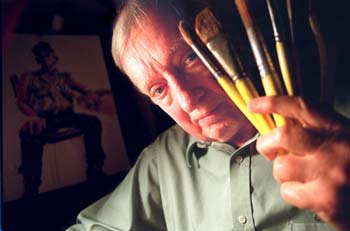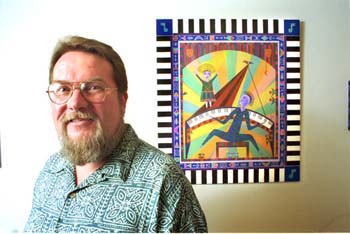![[MetroActive Arts]](/arts/gifs/art468.gif)
[ Santa Cruz Week | MetroActive Central | Archives ]
Brush With Fame: Local artist Bob Newick enjoys being part of Open Studios--and wishes everyone could participate.
Opening Salvos
Annual art scene event Open Studios faces perennial debate over selection and inclusion
By Julia Chiapella
FOR ART ENTHUSIASTS, voyeurs and the just plain curious, Open Studios looms like a beacon of enchantment. This weekend marks the 16th anniversary of the event and brings together nearly 280 artists who willingly open their homes and studios for the simple price of a catalog.
It's a nifty idea, really. For a mere $15, two people can go to as many studios as they'd like for three consecutive weekends. And since the event's inception in 1985, many say that Open Studios just gets better and better. Artist Faye Augustine recently attended the preview exhibit for Open Studios currently on display at the Santa Cruz Art League and liked what she saw: "The work is looking better every year."
But getting better at something usually means leaving something behind. For the Open Studios selection committee, that means picking certain artists whose slides of their work demonstrate technical proficiency, individual style and a cohesive body of work. Without meeting those criteria, an artist is unlikely to be accepted.
Every year as artists are notified of their acceptance or rejection, there's some noise made over the selection criteria. And every year, the Cultural Council reviews its methods and tries to please as many people as it can, a task that is ultimately foolhardy. "The Cultural Council just can't please all the artists," says Augustine, who has spent a couple of recent years on the Open Studios committee. "The panel really does a good job for what they're asked to do. They've accomplished a lot."
But there are those who have a simple solution to all the complaints voiced about the selection process: let everybody in. It's an idea that continually surfaces and one that the Cultural Council continually rejects, despite the opinions of several participating Open Studios artists.
Three-Week Tour: Close to 300 artists throw open their work spaces for three weekends.
BOB NEWICK IS ONE of those dissenting artists. Newick worked as a commercial artist for IBM before retiring and turning to painting 18 years ago. He's participated in Open Studios for 10 years and he's happy with just about everything. He's happy to have someone else run it. He's happy with the way it's run. But Newick doesn't like what he perceives as the exclusivity inherent in the event.
"I'd rather have them accept anyone who wants to come in," says Newick, who would prefer that the Cultural Council abandon its professionally slick catalog/calendar for a simple black-and-white one on newsprint. When told that that kind of presentation might attract fewer people and earn less money, he is unimpressed. "I would hope less people came and spent less money. It would still be more inclusive."
Artist D. Hooker agrees. Hooker's figures loom like characters out of some gothic novel--large eyes, dark outlines and distorted features give them a sense of tragic foreboding, a quality that is little apparent in Hooker's personal style. Engaging and relaxed, she's participated in Open Studios for years and says the Cultural Council does a really good job at what they do. But she thinks everything about Open Studios is too safe.
"I miss seeing the brand new artists that don't know how to put together their slides, or the really old people, or the ones that just can't quite get it together to do that scene," Hooker says. "I wish they would just put out a newsprint catalog, but it's not going to happen."
And it won't happen for a good reason, says Buff McKinley, events coordinator for the Cultural Council. McKinley says that every year the Cultural Council surveys participating Open Studios artists and visitors, and every year the majority of the responses want the event smaller. "The bigger the event gets, the less people come [to an individual artist's studio]," McKinley says.
Hooker argues that those numbers shouldn't matter. Though her work sells well at Open Studios, and she wouldn't like to see that change, she'd still like the event to be open to all comers. "You can't just support the artists that sell really well," says Hooker. "Part of the reason for Open Studios is to make money, but I'd like to see part of the reason to be to expose people to more kinds of art."
This, according to McKinley, can be problematic. "What we find anecdotally," says McKinley, "is that people go to the San Francisco Open Studios or the Silicon Valley Studios, where it's 'Y'all come,' and visitors find they do an awful lot of traveling. There's some fabulous work, but oftentimes it's not what's represented in the catalog: it's a hobbyist who made a wonderful piece or a student who made a wonderful piece, but they don't have a body of work to back it up."
All Keyed Up: Arist Jim Aschbacher hopes the Open Studios can attract more out-of-town visitors.
MCKINLEY AND JAMES Aschbacher, who's worked for five years on the Open Studios committee and is a participating artist as well, say the Cultural Council's Open Studios has received accolades for its professional presentation of quality work. It's a reputation, Aschbacher notes, that has other Open Studios looking to Santa Cruz as the model.
It's also one of the reasons people from the Bay Area come to visit Santa Cruz for Open Studios. And that, says Aschbacher, means the work needs to be quality. "Santa Cruz County has a great appreciation for artwork, but we're trying to draw more people from the Bay Area," Aschbacher explains. "We want to make sure the trip is worth it, that they're not going to see someone who's just goofing around."
Augustine says that many of the artists who object to the Open Studios exclusivity don't realize that the event is designed primarily for the public. The screening process came about, she says, "to please the public who's driving around and bringing their money into Santa Cruz County. It narrows it down and makes it better for everybody who's in it."
Add to this the Cultural Council's intention with Open Studios of helping artists learn how to market themselves, how to survive in the world as artists.
"The intent is to teach people that if you mean to survive, if this is going to be your livelihood, then there are certain professional practices you need to do. It's no great shame to be successful at the business of being an artist. There's a certain romance to bohemianism, and I don't mean to take that away. But I don't think it excuses you from not learning how to report your sales tax."
Hooker knows that the current state of Open Studios is unlikely to change. What she's hopeful about is the development of an alternative event, one that McKinley and Aschbacher both say has been discussed by the Cultural Council and would eliminate the stain of exclusivity attributed to Open Studios.
McKinley says that her vision for creating a solution to the Open Studios dilemma would be an event where "everybody can get in and get feedback." Such an event is "definitely in the hearts and minds of the planning process," she adds, "but there are no dates, nothing formal yet."
McKinley hints at and Aschbacher expands on one notion that's being kicked around at the Cultural Council: create an alternate event that's an Open Studios for all the arts. "You could open your dance studio, your music studio, your theater," Aschbacher says. "It would be a great event, a huge project."
While such a project would no doubt remove all accusations of exclusivity, its unwieldiness could potentially undermine its success. More realistic would be to create an alternative event to Open Studios, one that allows everyone entry.
Until then, there are still hundreds of artists opening their studios to the public. "Warts and all," McKinley says. "It's a great opportunity for people to get out there and see art."
Copyright © Metro Publishing Inc. Maintained by Boulevards New Media.
![]()

Photograph by George Sakkestad
![[line]](/gifs/line.gif)
![[line]](/gifs/line.gif)

Photograph by George Sakkestad
From the October 4-11, 2000 issue of Metro Santa Cruz.